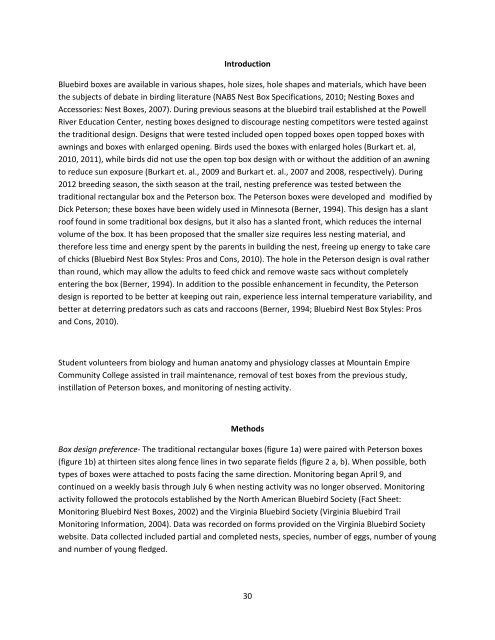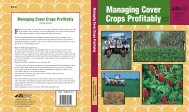A Study to Determine the Preference for Nesting Box Design of ...
A Study to Determine the Preference for Nesting Box Design of ...
A Study to Determine the Preference for Nesting Box Design of ...
You also want an ePaper? Increase the reach of your titles
YUMPU automatically turns print PDFs into web optimized ePapers that Google loves.
Introduction<br />
Bluebird boxes are available in various shapes, hole sizes, hole shapes and materials, which have been<br />
<strong>the</strong> subjects <strong>of</strong> debate in birding literature (NABS Nest <strong>Box</strong> Specifications, 2010; <strong>Nesting</strong> <strong>Box</strong>es and<br />
Accessories: Nest <strong>Box</strong>es, 2007). During previous seasons at <strong>the</strong> bluebird trail established at <strong>the</strong> Powell<br />
River Education Center, nesting boxes designed <strong>to</strong> discourage nesting competi<strong>to</strong>rs were tested against<br />
<strong>the</strong> traditional design. <strong>Design</strong>s that were tested included open <strong>to</strong>pped boxes open <strong>to</strong>pped boxes with<br />
awnings and boxes with enlarged opening. Birds used <strong>the</strong> boxes with enlarged holes (Burkart et. al,<br />
2010, 2011), while birds did not use <strong>the</strong> open <strong>to</strong>p box design with or without <strong>the</strong> addition <strong>of</strong> an awning<br />
<strong>to</strong> reduce sun exposure (Burkart et. al., 2009 and Burkart et. al., 2007 and 2008, respectively). During<br />
2012 breeding season, <strong>the</strong> sixth season at <strong>the</strong> trail, nesting preference was tested between <strong>the</strong><br />
traditional rectangular box and <strong>the</strong> Peterson box. The Peterson boxes were developed and modified by<br />
Dick Peterson; <strong>the</strong>se boxes have been widely used in Minnesota (Berner, 1994). This design has a slant<br />
ro<strong>of</strong> found in some traditional box designs, but it also has a slanted front, which reduces <strong>the</strong> internal<br />
volume <strong>of</strong> <strong>the</strong> box. It has been proposed that <strong>the</strong> smaller size requires less nesting material, and<br />
<strong>the</strong>re<strong>for</strong>e less time and energy spent by <strong>the</strong> parents in building <strong>the</strong> nest, freeing up energy <strong>to</strong> take care<br />
<strong>of</strong> chicks (Bluebird Nest <strong>Box</strong> Styles: Pros and Cons, 2010). The hole in <strong>the</strong> Peterson design is oval ra<strong>the</strong>r<br />
than round, which may allow <strong>the</strong> adults <strong>to</strong> feed chick and remove waste sacs without completely<br />
entering <strong>the</strong> box (Berner, 1994). In addition <strong>to</strong> <strong>the</strong> possible enhancement in fecundity, <strong>the</strong> Peterson<br />
design is reported <strong>to</strong> be better at keeping out rain, experience less internal temperature variability, and<br />
better at deterring preda<strong>to</strong>rs such as cats and raccoons (Berner, 1994; Bluebird Nest <strong>Box</strong> Styles: Pros<br />
and Cons, 2010).<br />
Student volunteers from biology and human ana<strong>to</strong>my and physiology classes at Mountain Empire<br />
Community College assisted in trail maintenance, removal <strong>of</strong> test boxes from <strong>the</strong> previous study,<br />
instillation <strong>of</strong> Peterson boxes, and moni<strong>to</strong>ring <strong>of</strong> nesting activity.<br />
Methods<br />
<strong>Box</strong> design preference‐ The traditional rectangular boxes (figure 1a) were paired with Peterson boxes<br />
(figure 1b) at thirteen sites along fence lines in two separate fields (figure 2 a, b). When possible, both<br />
types <strong>of</strong> boxes were attached <strong>to</strong> posts facing <strong>the</strong> same direction. Moni<strong>to</strong>ring began April 9, and<br />
continued on a weekly basis through July 6 when nesting activity was no longer observed. Moni<strong>to</strong>ring<br />
activity followed <strong>the</strong> pro<strong>to</strong>cols established by <strong>the</strong> North American Bluebird Society (Fact Sheet:<br />
Moni<strong>to</strong>ring Bluebird Nest <strong>Box</strong>es, 2002) and <strong>the</strong> Virginia Bluebird Society (Virginia Bluebird Trail<br />
Moni<strong>to</strong>ring In<strong>for</strong>mation, 2004). Data was recorded on <strong>for</strong>ms provided on <strong>the</strong> Virginia Bluebird Society<br />
website. Data collected included partial and completed nests, species, number <strong>of</strong> eggs, number <strong>of</strong> young<br />
and number <strong>of</strong> young fledged.<br />
30
















